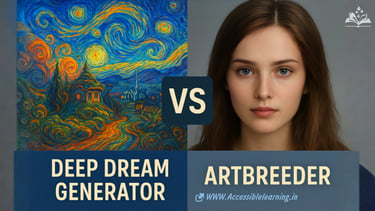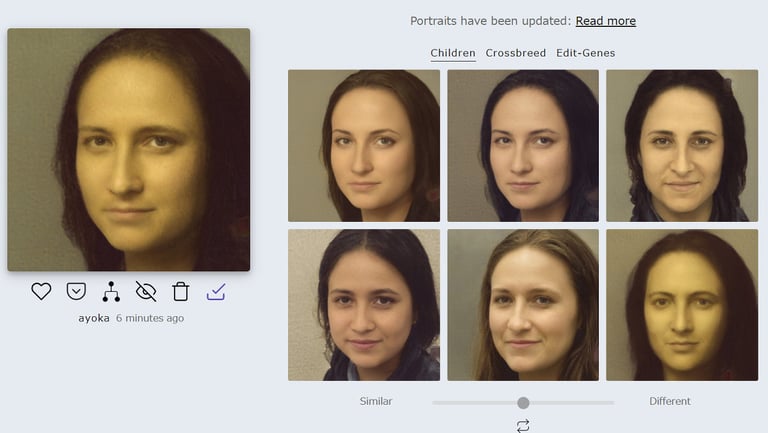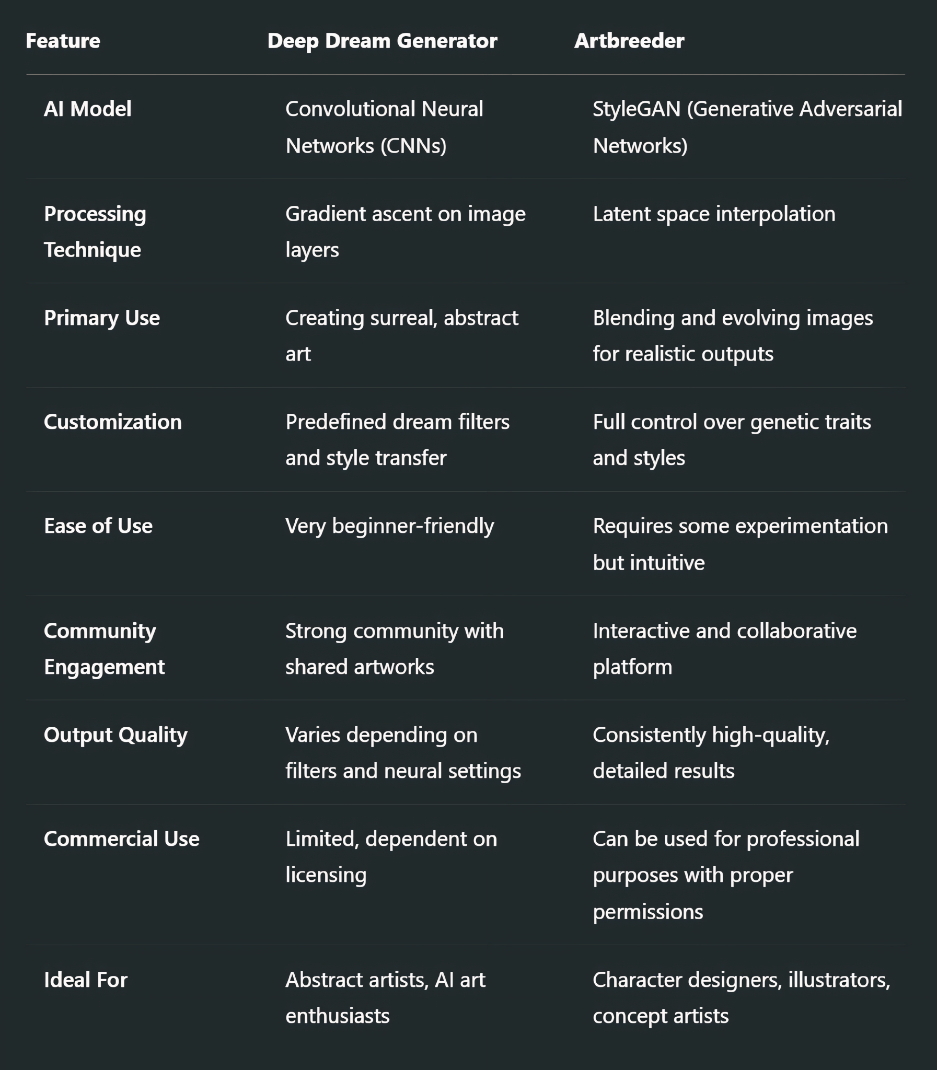
Deep Dream Generator vs. Artbreeder: AI-Powered Art Revolution
Explore the AI-powered art revolution with Deep Dream Generator and Artbreeder. Learn how these innovative platforms use neural networks and GANs to create surreal dreamscapes and realistic character portraits. Discover their key features, best use cases, and which tool suits your artistic needs!
AI/FUTUREAI ART TOOLSARTIST/CREATIVITY
Sachin K Chaurasiya
4/8/20254 min read


Artificial Intelligence (AI) has revolutionized the way artists and creatives generate unique and stunning visuals. Among the most popular AI-powered tools for artistic creation are Deep Dream Generator and Artbreeder. These platforms empower users to create mesmerizing, dreamlike images and enhance creativity through machine learning algorithms. But how do they differ, and which one is the best for you? Let’s dive deep into their features, capabilities, and ideal use cases.
What is Deep Dream Generator?
Deep Dream Generator is an AI-driven tool developed by Google that uses neural networks to transform ordinary images into surreal, hallucinogenic visuals. It utilizes a deep learning model inspired by the way the human brain processes images. Originally created as an experiment, Deep Dream quickly gained popularity for its ability to generate dream-like and abstract art.
Technical Details
AI Model: Convolutional Neural Networks (CNNs) trained on large datasets.
Processing Technique: Uses gradient ascent on image layers to amplify existing patterns.
Neural Layer Depth: Adjusting layer depth controls the intensity of the effect.
Training Data: Primarily trained on ImageNet and other large-scale visual datasets.
Performance Impact: Requires substantial computational power for high-resolution images.
Key Features
Neural Style Transfer—Users can blend their photos with famous artistic styles to create a unique effect.
Dream Filters—The tool applies various dream levels, adding depth and surrealism to images.
Multiple AI Models—Different neural network settings allow customization of the output.
User-Friendly Interface—Simple and intuitive, even for beginners.
Community Sharing—Users can explore and get inspired by artworks created by others.
Custom Training Options—Users can upload and train their own models for personalized results.
Commercial Licensing—Some plans offer licensing for professional use, making it useful for digital artists and designers.
Strengths
Unique Surreal Aesthetic—Creates dreamlike, psychedelic visuals unlike any other tool.
User-Friendly Interface—Simple and intuitive, great for beginners.
Neural Style Transfer—Allows users to apply artistic styles to existing photos.
Community Engagement—Users can share and explore AI-generated art.
Creative Experimentation—Ideal for abstract and experimental artists.
Weaknesses
Limited Control Over Output—Results are heavily dependent on preset filters.
Lower Resolution Images—Not always suitable for high-definition prints.
Less Customization—Compared to Artbreeder, customization is more limited.
Commercial Licensing Restrictions—Some outputs may require additional licensing for professional use.
Best Use Cases
Creating abstract and surreal artworks.
Enhancing ordinary photos with a dream-like effect.
Experimenting with neural networks to understand AI art generation.
Developing psychedelic-themed posters, album covers, and digital prints.
Generating creative content for social media, blogs, and marketing materials.


What is Artbreeder?
Artbreeder, on the other hand, takes a different approach to AI-generated art. Instead of applying dream-like filters, Artbreeder allows users to manipulate and evolve images using Generative Adversarial Networks (GANs). This tool enables the mixing of different visual elements, helping users create portraits, landscapes, anime-style art, and more.
Technical Details
AI Model: Uses a StyleGAN (Style-Based Generative Adversarial Network) for high-resolution image synthesis.
Processing Technique: Implements latent space interpolation to mix features of different images.
Customization: Users control variables like age, gender, expression, and artistic style.
Training Data: Uses a dataset of curated user-generated images.
Performance Impact: Runs efficiently through cloud computing and distributed processing.
Key Features
Genetic Image Manipulation—Users can blend and evolve images by adjusting traits and sliders.
Diverse Image Categories—Supports faces, landscapes, anime characters, abstract designs, and even album art.
High-Resolution Outputs—Generates ultra-high-quality images suitable for professional use.
Cloud-Based Storage—Saves all progress and iterations online for easy access.
Interactive Community—Users can collaborate and refine each other’s work.
Multi-Element Mixing—Combines multiple images to create unique hybrid results.
Text-Based Image Generation—Some advanced versions allow users to input text descriptions to modify images.
Strengths
High Customization—Users can manipulate facial traits, landscapes, and styles in great detail.
Generative Evolution—Allows gradual modification and blending of multiple images.
High-Resolution Outputs—Generates professional-grade images suitable for commercial use.
Diverse Categories—Can create faces, landscapes, abstract art, and more.
Collaborative Platform—Users can refine and improve each other’s work.
Weaknesses
Learning Curve—Requires some experimentation to master genetic image manipulation.
Less Suitable for Abstract Art—Focuses more on realistic image blending rather than surreal dreamlike effects.
Cloud-Based Dependency—Requires internet access for usage and saving progress.
Limited Instant Effects—Unlike Deep Dream, does not apply instant artistic transformations.
Best Use Cases
Creating realistic or stylized portraits.
Generating unique character designs for games, comics, or animations.
Developing concept art with minimal effort.
Enhancing creativity by experimenting with endless variations of images.
Creating family tree visualizations by blending different portraits.
Generating AI-assisted mood boards for projects and creative brainstorming.


Which One Should You Choose?
Choose Deep Dream Generator if…
You love surreal and psychedelic art.
You want to apply AI-generated styles to existing photos.
You prefer a simple interface with quick results.
You want to experiment with deep learning in art generation.
You are looking for abstract artwork for marketing or creative projects.
Choose Artbreeder if…
You need detailed and customizable character portraits or landscapes.
You want full control over genetic traits to modify images creatively.
You enjoy experimenting with AI-generated artwork that evolves over time.
You are a game designer, illustrator, or concept artist looking for unique inspirations.
You need AI-assisted character designs for projects, including NFTs and storytelling visuals.
Both Deep Dream Generator and Artbreeder push the boundaries of AI-powered creativity, each catering to different artistic needs. Whether you’re looking for a quick surreal transformation or a detailed character evolution, these platforms offer powerful tools to enhance your creativity. Additionally, both tools are constantly evolving, incorporating new AI models and techniques to expand their capabilities.
If you’re looking for AI-powered surrealism and dream-like effects, Deep Dream Generator is your best bet. However, if you need realistic, customizable image blending and character creation, Artbreeder is the way to go.
Whichever tool you choose, one thing is certain—AI-generated art is reshaping the creative landscape, offering limitless opportunities for artistic exploration. Try them out and see where your imagination takes you!
Which AI tool do you prefer for creating art? Share your thoughts in the comments!
Subscribe To Our Newsletter
All © Copyright reserved by Accessible-Learning Hub
| Terms & Conditions
Knowledge is power. Learn with Us. 📚


